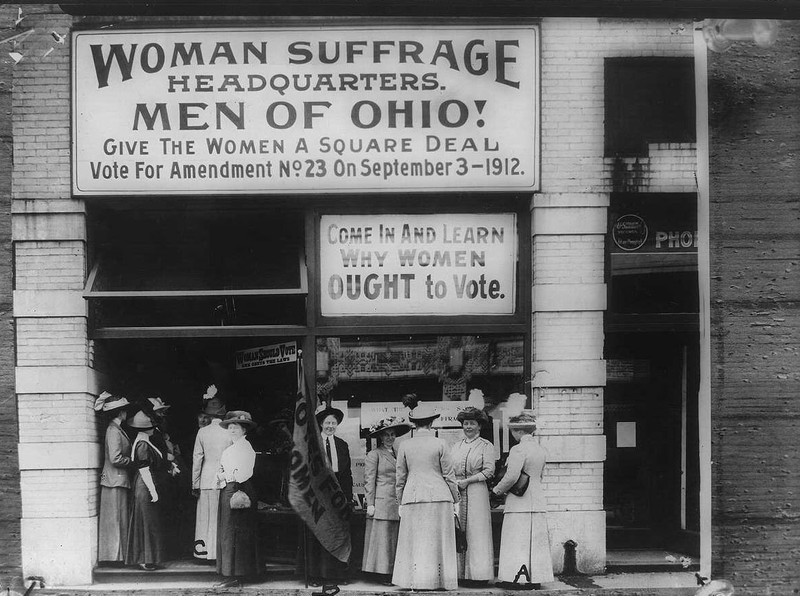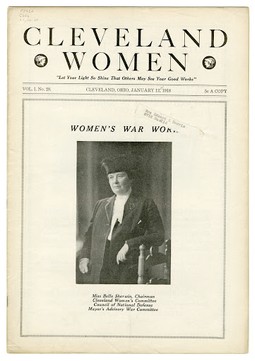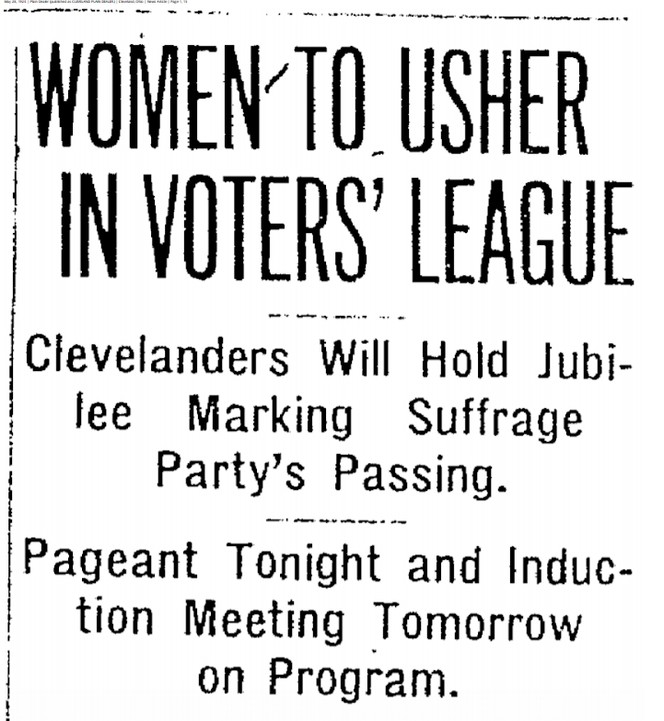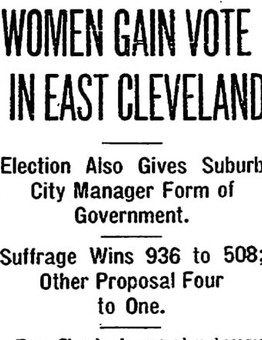Cleveland Woman's Suffrage Party Headquarters
Introduction
Text-to-speech Audio
Images
Woman Suffrage Headquarters, Cleveland; A (at extreme right) Miss Belle Sherwin, President, National League of Women Voters; B (holding the flag) Judge Florence E. Allen; C Mrs. Malcolm McBride

Belle Sherwin on the cover of "Cleveland Women" magazine, 1918

"Women to Usher in Voters' League" advertisement the day prior to the incorporation of the Woman's Suffrage Party into the Cleveland League of Women Voters

"Women Gain the Vote in East Cleveland" June 7, 1916

Backstory and Context
Text-to-speech Audio
East Cleveland was one of the earliest cities to grant women suffrage rights on June 6, 1916. On June 7, 1916, the Plain Dealer stated, "Women gain vote in East Cleveland," and "East Cleveland yesterday became the first city east of the Mississippi River to grant by home rule suffrage to women in municipal elections. The proposal carried in every one of four wards of the city, the total vote being 936 to 508." Cleveland was a hub of suffrage activity through the late 19th and 20th centuries. The American Woman Suffrage Association (AWSA) was organized in Cleveland on November 24, 1869 and held their first national convention at Case Hall on Superior Avenue in 1869. The AWSA was led by Lucy Stone and Julia Ward Howe, and would merge with the National Woman Suffrage Association (NWSA) to form the National American Woman Suffrage Association (NAWSA) in 1890.
The Cuyahoga County Woman's Suffrage Association was founded in 1910 by its director, Elizabeth Hauser. Hauser was one of the leading suffragists in Ohio, working alongside other lobbyists to gather 15,000 signatures on suffrage petitions for the 1912 Constitutional Convention in Columbus. On February 15, the Convention voted 76 to 34 in favor of submitting Amendment 23 for women's suffrage to vote at a special election on September 3. Though Amendment 23 was not passed, it added further momentum in the suffrage movement, as Ohio became the first state east of the Mississippi to vote on the question of universal suffrage. Following the convention, the Cuyahoga County Woman's Suffrage Association changed its name to the Cuyahoga County Woman's Suffrage Party, more often referred to as the Cleveland Woman's Suffrage Party. The Woman's Suffrage Party headquarters was located at 13435 Euclid Avenue, and acted as the social and political center for the suffrage movement in Cleveland.
Hauser recruited local society women to attend suffrage lectures and luncheons, including Lucia McCurdy McBride (Mrs. Malcolm L. McBride). McBride became the director of the Cleveland Woman's Suffrage Party, and the founder, financial secretary, and director of the Ohio Woman Suffrage Association (1911-1920). She was also a charter member and president (1920; 1933; 1943) of the Cleveland League of Women Voters. Harriet Keeler (1846-1921) acted as President of the Cleveland Woman's Suffrage Party in 1913, but stepped down due to health troubles. Keeler was a teacher, botanist, and author, and spent more than four decades in the Cleveland Public School system, serving a brief term as the city's first female superintendent. Minerva Brooks presided over the Woman's Suffrage Party in 1914, and played an integral role in securing women's suffrage in the city.
1915-16 were busy years for Cleveland suffragists, as they allocated their efforts to furthering the national and state campaigns, but also the local campaign: They held a membership drive to sign up all women not opposed to suffrage and advocated to secure municipal suffrage for East Cleveland. In 1914, East Cleveland passed the State Suffrage Amendment with a large majority, with Mayor Minshall in favor of women's suffrage. However, many did not believe the Amendment would be held as constitutional in the new Charter. The members of the Woman's Suffrage Party were optimistic that they could convince members of the Charter Commission to include women's suffrage on the upcoming ballot. Lawyer Florence E. Allen gave her arguments on the constitutionality of a suffrage clause, stating "the woman suffrage proposal is perfectly legal, having as a precedent the ruling of the Illinois Supreme Court which granted Chicago women municipal suffrage." A petition containing 1,403 names (about half of the women of East Cleveland eligible to vote) was presented to the Charter Commission, and eventually secured a spot on the ballot. On election day, June 6, 1916, the Municipal Suffrage Amendment won by a 426 vote majority. The victory in East Cleveland encouraged other localities, such as Lakewood in 1917, to pass their own Charter Amendments for women's suffrage on municipal issues.
In February 1917, James A. Reynolds, a Democratic Representative of Cuyahoga County, introduced a bill that petitioned for women's suffrage in presidential elections. The bill was passed by the Ohio House and Senate, and was put a vote in the November election as the Reynolds Presidential Suffrage Law, but was repudiated at the polls. Cleveland suffragists still considered the bill a victory, and Judge Florence E. Allen secured a victory in the East Cleveland case, when the Ohio Supreme Court upheld the 1916 Municipal Suffrage Amendment to the Charter.
Following the ratification of the 19th Amendment by the state of Ohio and the passing of the Reynolds-Fouts Presidential Suffrage bill on June 16, 1919, members of the Cleveland Woman's Suffrage Party voted to disband and allocate their membership of 80,000 to a new organization. The May 28, 1920 issue of the Plain Dealer states that the Woman's Suffrage Party celebrated their history at their Fifth Annual Convention with a pageant at the Duchess Theater. The convention resumed at the Hollenden Hotel on May 29, 1920, when the Suffrage Party officially disbanded, and president Mrs. Harris R. Cooley and members of the Executive Board resigned. Members reorganized as the Cleveland League of Women Voters, modernly known as the League of Women Voters of Greater Cleveland. The League is a nonpartisan group formed with the purposes of educating the woman voter, working for necessary legislation, and encouraging women to become involved in political affairs.
Sources
- Raponi, Richard. Harriet Keeler Memorial, Cleveland Historical. July 14 2014. Accessed June 1 2020. https://clevelandhistorical.org/index.php/items/show/663
- Case Western Reserve University. Keeler, Harriet Louise, Encyclopedia of Cleveland History. Accessed June 1 2020. https://case.edu/ech/articles/k/keeler-harriet-louise
- DeMarco, Laura. Women's History Month: Cleveland Suffragettes, Protests and Parades Since 1869, Cleveland.com. May 19 2019. Accessed June 1 2020. https://www.cleveland.com/entertainment/2017/03/womens_history_month_cleveland.html
- Abbott, Virginia Clark. The History of Woman Suffrage and the League of Women Voters in Cuyahoga County 1911-1945. Cleveland: The William Feather Company, 1949.
- Brosious, Sarah. League of Women Voters in Cleveland is 100 Years Old on May 29, 2020, Western Reserve Historical Society. May 28 2020. Accessed June 1 2020. https://www.wrhs.org/blog/?fbclid=IwAR1Mt9oaLdU0AObl9HBjBAiIGVNEc8AxRYVrMvyxg3_Al4zBdmkmJAr9fBw
- Stanton, Elizabeth Cady and Susan Brownwell Anthony. The History of Woman Suffrage: 1900-1920. Volume 5. New York: Fowler & Wells, 1922.
- Case Western Reserve University. Hauser, Elizabeth, Encyclopedia of Cleveland History. Accessed May 29 2020. https://case.edu/ech/articles/h/hauser-elizabeth
- Case Western Reserve University. Brooks, Minerva Kline, Encyclopedia of Cleveland History. Accessed June 2 2020. https://case.edu/ech/articles/b/brooks-minerva-kline
Library of Congress
Western Reserve Historical Society
Plain Dealer, NewsBank/American Antiquarian Society
Plain Dealer, NewsBank/American Antiquarian Society
